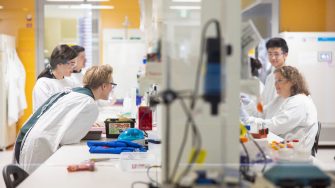
Devices
Early diagnosis is crucial for the treatment and cure of a range of pathologies including cancers. The challenge diagnosis is to quantify the level of biomarkers at very low concentrations. In the diagnostic devices focus area of the ACN, researchers are developing a range of biosensors that are capable of detecting ultra-low concentrations of important cancer biomarkers. These biomarkers are all present in whole blood and are hence consistent with the idea of the liquid biopsy.
The basis of these technologies is the development of nanomaterials that can both preconcentrate and detect the biomarker of interest combined with a well-defined surface chemistry to ensure the sensor only detects the desired biomarker.
Projects include detecting microRNA in whole blood at attomolar levels, detecting low levels of protein biomarkers such as prostate-specific antigen and detecting heterogeneity in rare cancer cells. The technologies can be applied for both early detection and treatment efficacy.
Current project
Detecting microRNA as a cancer biomarker
MicroRNAs are post transcriptional gene regulator that are found directly from circulating blood. The levels of the many different microRNAs can be up or down regulated with a range of pathologies including cancer. The analytical challenge is these biomarkers must be detected in the picomolar to nanomolar range. We have developed the concept of nucleic acid modified gold coated magnetic nanoparticles (referred to as dispersible electrodes) that can capture and detect specific microRNA sequences in whole blood over a broad dynamic range of nanomolar down to 10 attomolar. This unprecedented performance sees this as a promising technology for detecting these important biomarkers.
Imaging (MRI)
Design of Macromolecular contrast agents for magnetic resonance imaging
Magnetic resonance imaging (MRI) has emerged as one of the most powerful and widely used technique for noninvasive clinical diagnosis owing to its high degree of soft tissue contrast, spatial resolution, and depth of penetration. MRI contrast is determined by the relaxation times (T1, spin–lattice relaxation and T2, spin–spin relaxation) of in vivo water protons. According to the density and nature of the biological tissue, different contrasts can be observed.
To increase the contrast and the signal-to-noise ratio, contrast agents are usually administered to patients.These contrast agents can change the water relation in their surrounding by shortening T1 or increasing T2, resulting in hyperintense signals. The contrast agents are generally based on either iron oxide nanoparticles (providing negative contrast in T2-weighted images) or complexes of lanthanide metals (mostly containing gadolinium ions, providing positive contrast in T1-weighted images).
The Australian Centre of Nanomedicine designs the next generation of contrast agents by using nanotechnology. To achieve this aim, new functionalized iron oxide nanoparticles coated with biocompatible polymers are investigated. In contrast to conventional contrast agents, these nanoparticle contrast agents can be easily functionalized with therapeutic molecules, which can facilitate the accumulation of these agents in a specific tissue. By using this approach, a lower dose on contrast agents can be used.
These studies are limited but likely to be replicated and have a major international impact due to the generalisability and face validity of their results. The very limited available data indicate that rates of readmission to a non-index hospital (‘care fragmentation’) are markedly higher in Australia than in other countries, likely reflecting our public-private mix of hospital services and vast geography.
We’ll use linked hospital admission, Medicare and mortality data for more than 10 million surgical procedures on around 4.5 million Australian patients to quantify and characterise care fragmentation following common surgical procedures. This includes cardiac, orthopaedic, thoracic, vascular, abdominal, colorectal, urological, neurosurgical and gynaecological interventions). We will evaluate the impact on outcomes in Australia and identify the factors that influence care fragmentation—including features of the index hospital, index admission, post-discharge care, patient and payer.
Our findings will have important implications for Australian health policy, including identification of possible adverse impacts of centralisation of surgical services and of incentives to switch between private and public hospitals.
We’ll work with health system stakeholders to synthesise these implications and identify potential policy responses, which might include a focus on coordination of care transitions and better clinical integration and data exchange among private and public sectors.
Current project
Magnetic layered double hydroxide nanoparticles as dualmode magnetic resonance imaging contrast agent
Magnetic resonance imaging (MRI) is currently one of the most powerful non-invasive molecular imaging techniques for cancer diagnosis by providing anatomical images of tissues and organs with excellent spatial resolutions. The diagnostic capabilities of MR imaging can be greatly improved by introducing exogenous contrast agents (T1 or T2 weighted contrast agents) to enhance target tissue contrast through altering the relaxation time of nearby water protons. Dual-mode MR imaging has been explored to address the issues on single-mode MR imaging by combining T1 and T2 weighted contrast agent into one nano-platform. The project aims to develop a new dual-mode MRI contrast agent with high selectivity, superb relaxivity and desirable biocompatibility.
